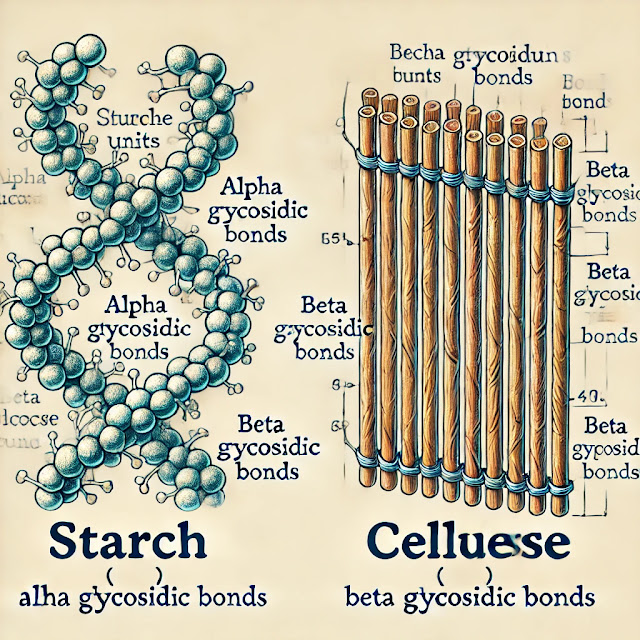Starch and cellulose are both polysaccharides composed of glucose units, but they have distinct chemical structures and properties, leading to different pharmaceutical significances.
Chemical Nature:
Composition:
- Starch: Composed of two types of glucose polymers—amylose (linear) and amylopectin (branched). Both consist of α-D-glucose units linked by α-1,4-glycosidic bonds, with amylopectin also having α-1,6-glycosidic branches.
- Cellulose: Composed of β-D-glucose units linked by β-1,4-glycosidic bonds, forming a linear, unbranched polymer. This structure allows for extensive hydrogen bonding between chains, leading to a rigid and crystalline structure.
Structure:
- Starch: The α-glycosidic bonds in starch lead to a coiled, flexible structure. Amylose forms a helical structure, while amylopectin has a branched, tree-like structure.
- Cellulose: The β-glycosidic bonds in cellulose result in a straight, rigid structure. The linear chains of cellulose align parallel to each other, creating strong intermolecular hydrogen bonds that contribute to its fibrous nature.
Solubility:
- Starch: Soluble in hot water, forming a colloidal dispersion or gel due to the swelling and gelatinization of amylose and amylopectin.
- Cellulose: Insoluble in water and most organic solvents due to its tightly packed structure and extensive hydrogen bonding.
2. Pharmaceutical Significance:
Starch:
- Use as an Excipient: Starch is widely used in the pharmaceutical industry as an excipient. It serves as a binder, disintegrant, and filler in tablet formulations. Modified starches are also used as film-forming agents in coatings.
- Drug Delivery: Starch can be modified to form nanoparticles or hydrogels for controlled drug delivery systems, leveraging its biocompatibility and biodegradability.
- Digestibility: Starch is digestible by humans due to the action of enzymes like amylase, which breaks down the α-glycosidic bonds, making it a source of glucose and energy.
Cellulose:
- Use as an Excipient: Cellulose derivatives, such as microcrystalline cellulose (MCC), carboxymethyl cellulose (CMC), and hydroxypropyl methylcellulose (HPMC), are extensively used in pharmaceuticals as binders, disintegrants, thickeners, and stabilizers. They provide structural integrity to tablets and capsules and control the release of active ingredients.
- Drug Delivery: Cellulose and its derivatives are employed in the formulation of controlled-release systems, transdermal patches, and as matrix formers in sustained-release tablets due to their ability to form gels and control drug release rates.
- Insolubility and Stability: Native cellulose is not digestible by humans due to the β-glycosidic bonds, which our digestive enzymes cannot break down. This property makes it useful as a dietary fiber supplement to promote digestive health.
Summary:
- Starch and cellulose are both glucose-based polysaccharides but differ in their glycosidic linkages (α in starch and β in cellulose), leading to significant differences in structure, solubility, and digestibility.
- Starch is primarily used in pharmaceuticals as an excipient and in drug delivery systems due to its digestibility and solubility.
- Cellulose and its derivatives, due to their insolubility and ability to form gels, are essential in the formulation of controlled-release systems, excipients, and as a source of dietary fiber.
These differences underscore their distinct roles and utilities in pharmaceutical applications.













0 Comments
Thanks for your feedback, ll get back to you soon